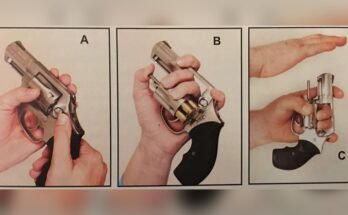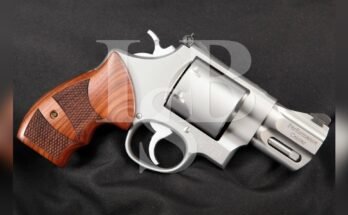If you own a revolver or are planning to handle one, knowing how to safely unload it is crucial. You might feel unsure or even a bit nervous about the process—that’s completely normal.
But imagine the confidence you’ll gain by mastering this skill. You will learn clear, step-by-step instructions to unload your revolver safely and effectively. Keep reading, because your safety and peace of mind depend on it.
Types Of Revolvers
Revolvers come in different types. Knowing these types helps in handling and unloading them safely. Each type works in a unique way. Understanding these differences is key to proper use and care.
Below, we discuss two main types and the common calibers you might see.
Single-action Vs Double-action
Single-action revolvers require you to pull back the hammer before each shot. This action also rotates the cylinder to the next round. They are simple and often have a lighter trigger pull.
Double-action revolvers let you pull the trigger to cock and fire in one move. You can also cock the hammer manually for a lighter trigger pull. This type offers faster shooting but with a heavier trigger pull.
Common Calibers
Revolvers come in many calibers. Popular ones include .22 LR, .38 Special, and .357 Magnum. Each caliber fits specific needs like target shooting or self-defense.
Smaller calibers have less recoil and are easier to handle. Larger calibers offer more stopping power but require more skill. Choosing the right caliber helps in safe unloading and use.
Basic Revolver Anatomy
A revolver is a type of handgun known for its unique design. Understanding its basic parts helps in safe handling and unloading. Each part has a clear function that works together to load, fire, and unload bullets. Knowing these parts makes the unloading process easier and safer.
Cylinder And Chambers
The cylinder is the round part of the revolver that holds the bullets. It spins around to align each bullet with the barrel. Inside the cylinder are chambers, small holes where bullets sit. Each chamber holds one bullet. The number of chambers varies, usually five or six. The cylinder swings out or stays fixed depending on the revolver model.
Loading Gate And Ejector Rod
The loading gate is a small door on the side of the revolver. It opens to allow access to the chambers for loading or unloading. The ejector rod is a thin metal rod located under the barrel. It pushes spent cartridges out of the chambers. Pressing the ejector rod helps remove empty cases quickly and safely.
Preparing To Unload
Preparing to unload a revolver requires careful steps to ensure safety. Always treat the firearm as if it is loaded. Taking the right precautions prevents accidents and keeps everyone safe.
Before unloading, create a calm and focused environment. Avoid distractions and keep your attention on the task. This mindset helps you handle the revolver correctly and securely.
Safety First: Check The Muzzle
Always point the muzzle away from yourself and others. This is the most important safety rule. Never aim the revolver at anything you do not intend to shoot.
Look down the barrel only from a safe angle, never directly. This ensures you do not accidentally point the gun at yourself. Keeping the muzzle in a safe direction reduces risk.
Engage The Safety If Available
Check if your revolver has a safety mechanism. Many revolvers do not have a manual safety, but some models do. Engage the safety before handling the cylinder or unloading.
Activating the safety helps prevent accidental firing. Keep the safety on until you are ready to fire again. This small step adds an extra layer of protection.

Step-by-step Unloading Process
Unloading a revolver safely is very important. Follow these steps carefully to remove all bullets. This process helps prevent accidents and keeps you and others safe. Understanding each step makes unloading quick and easy.
Open The Cylinder
Hold the revolver firmly with one hand. Locate the cylinder release latch, usually on the left side. Push or slide the latch to unlock the cylinder. Swing the cylinder out gently to the side. This exposes the chambers holding the bullets.
Ejecting Spent And Live Rounds
Point the revolver upward or slightly angled. Press the ejector rod located under the barrel. Push the rod fully to eject all cartridges from the chambers. Check that all rounds, spent or live, fall free. Remove any stuck rounds carefully with fingers or tool.
Visually Inspecting The Chambers
Look inside each chamber clearly. Make sure none contain bullets or shell casings. Use a flashlight if needed to see well. Verify all chambers are empty before closing the cylinder. This final check ensures the revolver is safe to handle or store.
Common Mistakes To Avoid
Unloading a revolver safely is very important. Many people make simple mistakes that can cause accidents. Knowing what to avoid helps keep you and others safe. Here are common errors to watch out for during the unloading process.
Failing To Clear The Firearm Completely
Some users stop checking too early. They might think the revolver is empty after removing one or two rounds. This mistake leaves live bullets in the cylinder. Always open the cylinder fully and check each chamber. Use your fingers or a tool to feel if any rounds remain. Never assume the gun is clear without a full check.
Handling Without Proper Grip
Holding the revolver incorrectly can cause it to slip or drop. This can accidentally fire a bullet or damage the gun. Use a firm and steady grip with both hands. Keep your finger away from the trigger at all times. Secure the cylinder open while unloading. A proper grip helps you control the revolver safely and smoothly.
Storing Your Revolver Safely
Storing your revolver safely is crucial for every gun owner. Proper storage helps prevent accidents and keeps the firearm secure from unauthorized use. A safe storage routine protects your family and others around you. It also preserves the revolver’s condition over time.
Use Of Gun Locks
Gun locks are simple devices that block the trigger or cylinder. They stop the revolver from firing. Use a cable lock or a trigger lock for extra safety. These locks are affordable and easy to use. They add a strong layer of protection when you store your revolver.
Appropriate Storage Locations
Choose a cool, dry place away from children and pets. A locked gun safe or cabinet works best. Avoid storing your revolver in drawers or open shelves. Secure spots reduce the risk of theft and accidents. Make sure the storage location is easy for you to access quickly when needed.
When To Seek Professional Help
Knowing when to seek professional help with your revolver is very important. Unloading a revolver can be simple. But problems may arise. Some issues need expert care to keep you safe and your firearm working well.
Malfunctions During Unloading
Sometimes the revolver may jam or not eject rounds properly. This can cause dangerous situations. A professional gunsmith has the tools and knowledge to fix these problems safely. Do not force the cylinder or try to fix jams by yourself. This could damage the revolver or cause injury.
Routine Maintenance Checks
Regular maintenance keeps your revolver in good shape. A gunsmith can check for wear and tear that you might miss. They clean parts that are hard to reach. Professionals ensure the revolver functions correctly and safely. Scheduling routine checks prevents bigger problems later.


Frequently Asked Questions
How Do You Safely Unload A Revolver?
To safely unload a revolver, first keep it pointed in a safe direction. Open the cylinder fully and eject all cartridges. Visually inspect each chamber to ensure it is empty. Always handle the revolver with care to prevent accidental discharge.
What Tools Help In Unloading A Revolver?
Generally, no special tools are needed to unload a revolver. Most revolvers have a built-in ejector rod to push out cartridges. Simply use your hand to open the cylinder and press the rod to eject rounds safely.
How Can I Check If A Revolver Is Fully Unloaded?
Open the cylinder and visually inspect each chamber. Make sure all cartridges and casings are removed. Physically feel the chambers if necessary. This confirms the revolver is completely unloaded and safe to handle.
Why Is It Important To Unload A Revolver Properly?
Proper unloading prevents accidental discharge and ensures safety. It protects you and others from injury. It also helps maintain the firearm’s condition by avoiding unnecessary handling of live rounds.
Conclusion
Unloading a revolver safely is very important. Always keep the gun pointed away from yourself and others. Open the cylinder fully to see all the chambers. Remove all the cartridges one by one carefully. Double-check the cylinder to make sure it is empty.
Handling a revolver with care prevents accidents. Practice these steps regularly to stay confident. Safety first, every time you handle a firearm. Remember, simple actions save lives and avoid danger. Stay calm, focused, and responsible when unloading your revolver.



